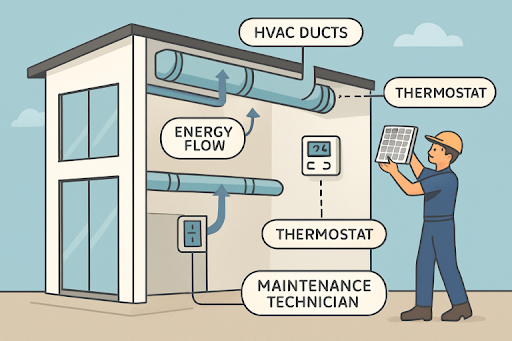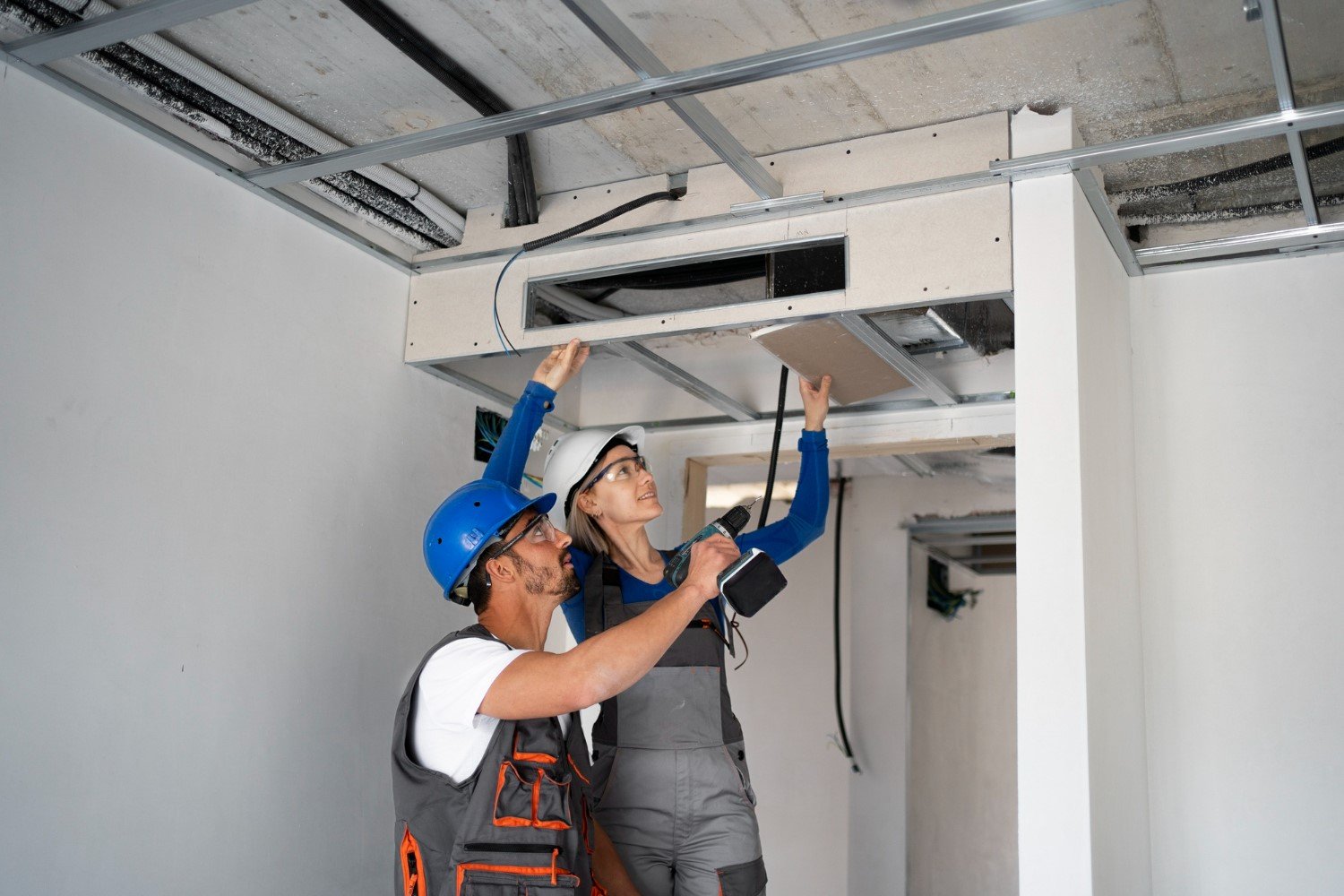Key Takeaways
- Consistent HVAC maintenance is crucial for maintaining system longevity and ensuring optimal energy efficiency.
- AI and IoT technologies enable real-time monitoring and predictive repairs.
- Energy-efficient materials and zoning designs support sustainable operations.
- Continuous training is critical for keeping maintenance personnel up to date.
Table of Contents
- Regular Maintenance: The Foundation of HVAC Efficiency
- Embracing Smart Technology and AI
- Energy-Efficient Materials and Designs
- Implementing Zoning Systems
- Utilizing IoT-Enabled Systems
- Adopting Predictive Maintenance Strategies
- Training and Education for Maintenance Personnel
- Conclusion
In today’s commercial and residential environments, optimizing HVAC systems isn’t just about comfort—it’s about efficiency, sustainability, and long-term cost savings. The foundation of these outcomes begins with a serious commitment to maintenance, careful system upgrades, and the strategic adoption of new technology. For building managers in competitive urban environments, working with an expert HVAC company can streamline everything from preventive care to advanced system integrations. Properly managed HVAC systems not only protect air quality and occupant well-being but also reduce energy costs throughout the building’s lifecycle.
Understanding modern HVAC solutions means looking beyond basic system checks and investing in a holistic strategy. Today’s advanced HVAC companies employ a combination of proactive maintenance, digital intelligence, and smart materials—all designed to push the boundaries of energy efficiency and indoor air quality management. These best practices lay the groundwork for reliable temperature control, predictable energy use, and reduced environmental impact.
Regular Maintenance: The Foundation of HVAC Efficiency
Routine maintenance is the cornerstone of HVAC system performance. Cleaning or replacing air filters, inspecting ductwork, and ensuring refrigerant levels meet manufacturer standards all prevent efficiency loss and expensive system breakdowns. Systematic maintenance improves not only the efficiency and lifespan of HVAC units but also enhances occupant comfort and indoor air quality. Facilities with structured maintenance routines report fewer emergency repairs and enjoy more predictable operating costs. A proactive approach also supports compliance with local building codes and warranty requirements. Beyond filters and refrigerants, professional maintenance checks often reveal issues like inefficient blower operation, worn belts, or clogged condensate drains. Early detection of these issues can lead to substantial energy savings and a smaller carbon footprint. Partnering with a reliable provider of HVAC services ensures that these inspections are thorough and up-to-date, utilizing the latest technologies and methods. Regularly scheduled maintenance not only extends the system’s overall lifespan but also protects your investment. Moreover, it offers peace of mind by reducing the risk of unexpected breakdowns and expensive emergency repairs

Embracing Smart Technology and AI
The rise of AI-powered controls and smart building technology is transforming how HVAC systems are monitored and adjusted. These tools automatically identify system inefficiencies, predict component failures, and fine-tune operations without human intervention. For example, studies indicate that artificial intelligence can reduce HVAC energy use by nearly 16%, significantly cutting operational costs and environmental impact. According to Time, AI is being applied in commercial buildings to optimize energy consumption, demonstrating measurable improvements in efficiency and sustainability.
With AI-driven analytics, building managers receive alerts about abnormal performance trends, helping to schedule repairs before disruptions occur. This technology can also forecast peak energy loads and recommend adjustments to achieve optimal system balance, supporting sustainability initiatives and enhancing long-term asset value.
Energy-Efficient Materials and Designs
Choosing innovative insulation and thermal barrier materials is just as crucial as selecting the right HVAC equipment. Modern solutions, such as aerogel insulation and vacuum-insulated panels, outperform conventional materials by minimizing heat transfer and reducing the load on HVAC units. As a result, buildings can maintain desired temperatures with less energy input, further supporting operational efficiency and comfort.
Recent advancements in design also integrate high-performance window glazing and automated shading solutions, amplifying the impact of energy-efficient HVAC systems. These strategies are propelling the industry toward new standards of environmental stewardship and occupant wellbeing.
Implementing Zoning Systems
Zoning technology divides large buildings or multi-level homes into distinct areas, each of which is managed with independent controls. This approach tailors heating and cooling to match usage patterns and occupancy, thereby preventing energy waste in unoccupied zones. Not only does zoning increase occupant comfort, but it also leads to significant cost savings—particularly in spaces with varying usage throughout the day.
Zoning can be particularly impactful in offices, mixed-use buildings, and educational facilities, where room needs fluctuate. Properly designed zoning strategies also extend the life of HVAC components by reducing continuous demand on the system as a whole.
Utilizing IoT-Enabled Systems
Internet of Things (IoT) devices, ranging from smart thermostats to wireless occupancy sensors, enable the efficient and straightforward real-time control and monitoring of HVAC equipment. These devices provide actionable data on system performance, energy consumption, and building use, allowing for dynamic adjustments that reduce energy waste. IoT systems learn user preferences, adjust temperature settings, and adapt to seasonal patterns automatically, resulting in measurable energy savings.
By integrating with broader building management platforms, IoT-enabled HVAC systems can be remotely monitored and adjusted. This centralizes control and reporting, making building-wide energy management more agile and transparent.
Adopting Predictive Maintenance Strategies
Predictive maintenance takes HVAC care a step further by using sensors and analytics to predict system wear and potential failure points. Maintenance can then be scheduled proactively, addressing issues before they result in costly breakdowns or lost productivity. This proactive stance extends equipment life, reduces unscheduled downtime, and ensures that systems run at peak efficiency.
Predictive tools can analyze vibration, temperature, and pressure data in real time, allowing technical staff to intervene precisely where needed, rather than relying solely on routine checklists.
Training and Education for Maintenance Personnel
Ongoing professional development is essential for those responsible for maintaining advanced HVAC systems. Industry trends, regulatory standards, and new technologies are constantly evolving, making routine training and certification essential. Well-trained staff can recognize and resolve issues efficiently, ensuring systems operate within manufacturer specifications and regulatory guidelines.
Access to updated training and resources—whether through manufacturer partnerships, trade organizations, or third-party education programs—empowers maintenance teams to deliver consistent results and uphold building performance objectives.
Conclusion
Modern HVAC maintenance is much more than periodic filter swaps. It’s an evolving practice that blends advanced analytics, new building materials, IoT connectivity, and workforce training to drive performance and sustainability. By prioritizing regular maintenance, leveraging digital tools, and collaborating closely with a skilled company, building managers can ensure their systems deliver reliable comfort, manage costs effectively, and minimize environmental impact for years to come.





